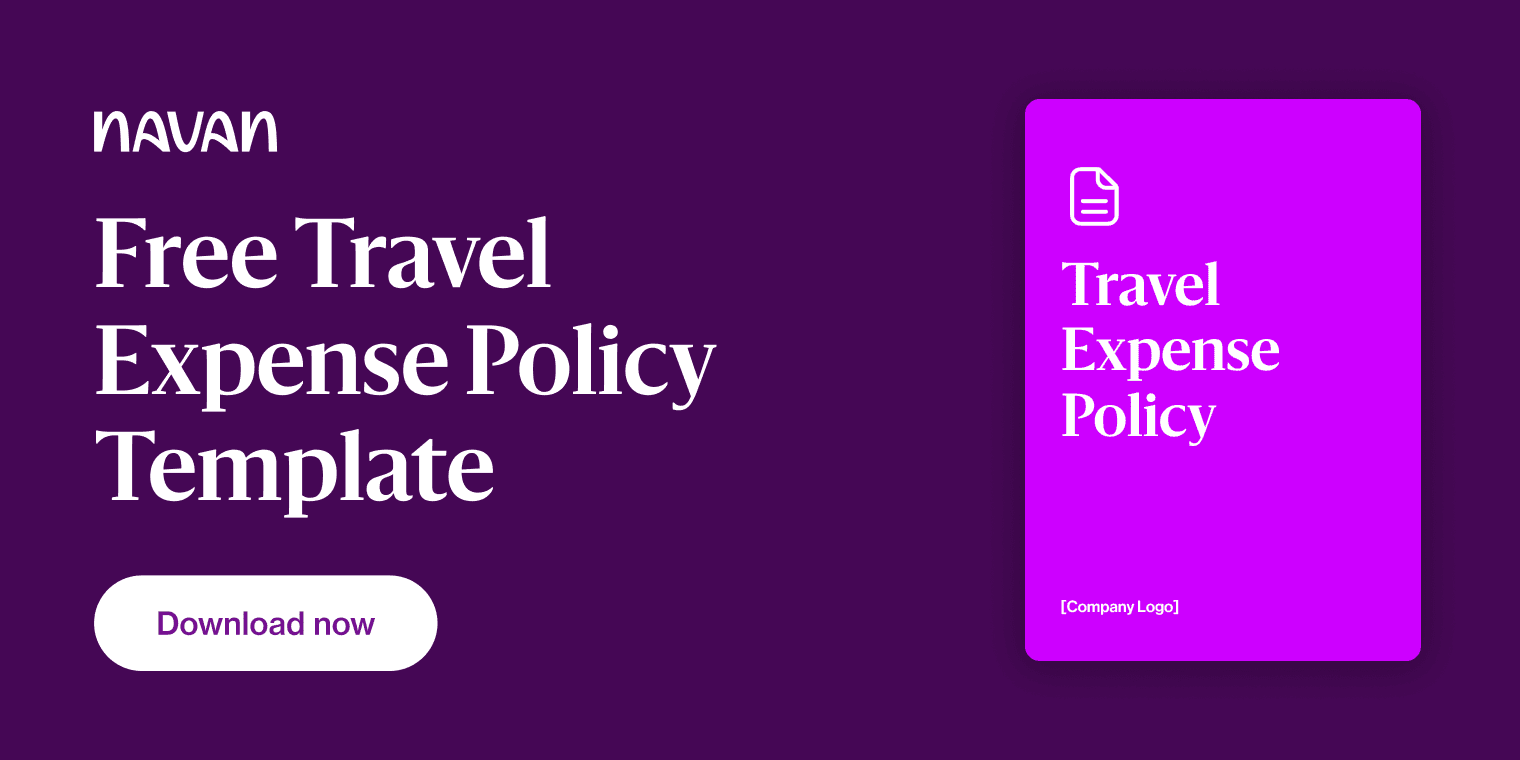A Comprehensive Guide to Employee Travel Allowance Policies

With business travel on the rise in 2025, it’s essential for companies to evaluate how they manage employee travel expenses. A central piece of the puzzle is managing employee travel allowances — a structured way to support travel-related costs while maintaining control over budgets and compliance.
Understanding how to develop and manage employee travel allowance policies is key for corporate travel managers, HR leaders, and finance professionals looking to streamline operations and deliver a consistent employee experience.
Defining Employee Travel Allowance
An employee travel allowance is a predefined sum of money or financial support provided by an employer to cover expenses incurred during business travel. These expenses typically include transportation, lodging, meals, and incidental costs like internet access or parking fees. Unlike traditional reimbursements, which require employees to pay out of pocket and submit receipts after the trip, travel allowances are often paid in advance or calculated using set daily rates.
Confusion may arise when comparing travel allowances to reimbursement models. While both aim to cover business-related travel expenses, they operate differently. Reimbursements rely heavily on itemized receipts and post-travel claims, while allowances provide predictability and simplicity up front. Getting this distinction right is critical to designing an efficient policy.
Common Types of Travel Allowances
Employee travel allowances can be structured in several ways, each of which offers different levels of flexibility and control. Selecting the right model depends on company size, travel frequency, and administrative preferences.
Fixed Allowance
The fixed-allowance model provides employees with a set amount of money to cover travel expenses, regardless of their actual spend. This method is often used by companies with consistent and predictable travel patterns. It simplifies budgeting and eliminates the need for employees to submit detailed receipts. However, it may not always reflect real costs, particularly for trips to high-cost destinations or during peak seasons.
Per Diem Allowance
The per diem model assigns daily rates for specific expense categories such as lodging, meals, and incidentals. These rates are often tied to government benchmarks — like the GSA (General Services Administration) in the U.S. or HMRC (His Majesty’s Revenue and Customs) in the UK — which vary by destination. This approach offers greater fairness and transparency, especially when employees travel to locations with differing costs of living. It also significantly reduces paperwork, as employees aren’t required to itemize every expense within the daily limit.
Despite its efficiency, many organizations underutilize the per diem system, often defaulting to reimbursement-heavy processes that add unnecessary administrative burdens.
Hybrid Reimbursement Model
Some companies adopt a hybrid model that blends elements of allowances and reimbursements. For example, high-cost items like flights and hotels may be prepaid or booked through a company portal, while daily expenses such as meals and local transportation are covered by a per diem. This structure balances control over major travel costs with flexibility for smaller, on-the-go expenses. It also gives finance teams more visibility into large-ticket items while keeping day-to-day employee spending simple and predictable.
Benefits of Implementing Travel Allowance Policies
A well-crafted travel allowance policy delivers multiple benefits to both employers and employees. First and foremost, it creates predictability and control over travel spending. When allowances are defined upfront, finance teams can forecast expenses more accurately and avoid budget overruns.
Clear policies also reduce ambiguity and support tax compliance — a critical aspect that may be overlooked. For example, the IRS (Internal Revenue Service) offers specific guidance on what qualifies as a tax-free allowance and what counts as taxable income. By following these guidelines, businesses can minimize legal risks and avoid costly errors during audits.
Additionally, a transparent travel allowance policy can improve employee satisfaction. Travel policies hold such significance that almost two-thirds of (59%) business travelers say a company’s travel policy influences their decision when evaluating a potential employer, according to a GBTA (Global Business Travel Association) survey.
Business travelers gain a greater sense of security knowing what expenses are covered, how much they will receive, and when payments will be made. This clarity reduces friction and helps avoid disputes over reimbursements or policy misunderstandings.
Most importantly, structured policies support fairness across the organization. Without clear rules, inconsistencies may arise between departments or individuals, leading to morale issues or claims of inequity. A consistent allowance framework levels the playing field.
Key Components of an Effective Travel Allowance Policy
Crafting a robust travel allowance policy involves more than assigning rates. It requires careful planning and documentation to avoid confusion and misuse.
Begin by outlining eligibility criteria — specify which employees qualify for travel allowances and under what circumstances. Define what types of travel count as “business-related” and who is authorized to approve trips.
Next, list covered expenses. These typically include meals, lodging, transportation, and incidentals but may exclude things like room service, mini-bar purchases, or personal upgrades. One of the most common policy mistakes is failing to spell out non-reimbursable expenses, which can lead to inconsistent claims and potential policy abuse.
Your policy should also describe the documentation requirements. Even when using set allowances, it’s good practice to request basic proof of travel, such as flight confirmations or hotel invoices, especially for partially reimbursed or taxed allowances.
Finally, define the approval workflow. Clarify who needs to authorize travel and how funds are distributed — whether through payroll, prepaid cards, or expense management software. Having these controls in place helps streamline the process and reduce delays.
How Duolingo Saves Nearly 2,000 Hours a Year with Navan
Before switching to Navan, Duolingo — the world’s leading language-learning platform — faced several business travel challenges. One major pain point was its approval workflow: Each expense required individual sign-off, creating unnecessary delays and administrative overhead.
Since implementing Navan, Duolingo has adopted a streamlined approval process that drastically reduces manual work and improves operational efficiency.
“When we did our analysis of switching to Navan, we calculated that we would save close to 2,000 hours a year!”
— Taylor Proie, Staff Accountant at Duolingo
Read the full case study to learn how Duolingo modernized its travel and expense management with Navan.
Integrating Technology for Efficient Travel Expense Management
Technology is playing a transformative role in how businesses manage travel allowances. Yet many companies still rely on outdated systems, spreadsheets, or manual approval chains, which leads to errors and inefficiencies.
Modern travel and expense platforms like Navan offer tools that automate policy enforcement, track spending in real time, and reduce the administrative burden on HR and finance teams. For example, by configuring allowance limits directly in the system, managers can approve trips without endless back-and-forth, while employees receive funds faster and with less paperwork.
Data analytics is another powerful feature. With a centralized platform, organizations can monitor spending trends, spot policy violations, and optimize budgets across departments and regions. These insights are invaluable for organizations with growing or global workforces.
Digitizing the travel allowance process also improves the employee experience. Mobile apps and intuitive dashboards let travelers view their allowance details, upload documentation, and check approvals on the go. This seamless interface is a significant upgrade over emailing spreadsheets and waiting for finance sign-off.
FAQ
Meet Navan
Navan provides a modern, all-in-one platform designed to simplify travel allowance and expense management. With smart policy configuration, automated workflows, and real-time visibility, Navan helps businesses manage employee travel allowances with confidence.
The platform allows finance teams to gain full control over budgets, HR leaders to maintain consistency, and employees to benefit from a user-friendly interface that helps make business travel easy.
By integrating travel booking, expense tracking, and reporting into one seamless experience, Navan supports businesses looking to scale their travel programs without sacrificing control or compliance.

Summary
Employee travel allowance policies are a cornerstone of financial control and employee support. By clearly defining expense categories, choosing the right allowance model, and adopting advanced technology, companies can manage travel costs more effectively while reducing administrative overhead.
Structured policies not only protect budgets and meet regulatory requirements but also contribute to a better employee experience.
With platforms like Navan, organizations can move beyond spreadsheets and manual approvals to a system that is agile, accurate, and scalable for the future of business travel.
Looking to upgrade your business travel management experience? Discover how Navan’s solution can help you achieve your goals.
This content is for informational purposes only. It doesn't necessarily reflect the views of Navan and should not be construed as legal, tax, benefits, financial, accounting, or other advice. If you need specific advice for your business, please consult with an expert, as rules and regulations change regularly.
More content you might like
Take Travel and Expense Further with Navan
Move faster, stay compliant, and save smarter.
